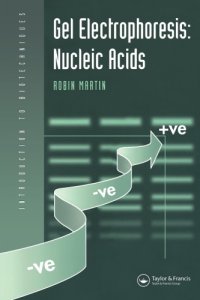
Ebook: Gel electrophoresisds nucleic acids
Author: Martin Robin
- Tags: Gel electrophoresis, Nucleic acids--Analysis, SCIENCE / Life Sciences / Biology / Microbiology, SCIENCE / Life Sciences / Cytology, SCIENCE / Life Sciences / General, Electronic books, Nucleic acids -- Analysis
- Year: 2020
- Publisher: Garland Science
- City: New York
- Language: English
- pdf
Abbreviations -- Preface -- PART 1: BASIC PRINCIPLES AND METHODS -- 1. Introduction: the Variety and Forms of Nucleic Acids -- Overview -- Electrophoresis and the properties of nucleic acids -- The variety and forms of nucleic acid -- References -- 2. The Theory of Nucleic Acid Electrophoresis -- The movement of nucleic acids in liquids and in gels -- Electric currents and buffer solutions -- Nucleic acids in solution -- Nucleic acids in gels -- The movement of nucleic acids through gels in constant electric fields -- Ogston sieving -- Reptation -- Migration as rigid rods -- The movement of nucleic acids through gels in pulsed electric fields -- References -- 3. The Electrophoresis of Native and Denatured Nucleic Acids -- The control of base pairing -- Physical and chemical denaturants for nucleic acid gel electrophoresis -- Temperature -- Alkaline conditions -- Methyl mercuric hydroxide, glyoxal and formaldehyde: denaturants for RNA in agarose gels -- Urea and formamide -- The binding of proteins to nucleic acids during gel electrophoresis -- References -- 4. The Choice of Format: Horizontal or Vertical, Agarose or Polyacrylamide? -- Apparatus for horizontal and vertical gels -- Apparatus for horizontal agarose gels -- Apparatus for vertical polyacrylamide gels -- Power supplies for nucleic acid gel electrophoresis -- Agarose gel media for nucleic acid electrophoresis -- Modified agarose preparations -- Low melting point agarose -- Higher strength agarose -- High-sieving agarose -- Visigel"' -- Ready-made agarose gels -- Polyacrylamide gel media for nucleic acid gel electrophoresis -- Modified polyacrylamide formulations -- Ready-made polyacrylamide gels -- Wedge shaped gels -- Toxicity of the components of polyacrylamide gels -- References -- 5. The Detection of Nucleic Acids Following Electrophoretic Separation -- Overview -- The principles of nucleic acid detection -- Binding with fluorescent dyes -- Labeling with radioactive nucleotides -- Labeling with fluorescent nucleotides -- Labeling nucleic acids with specific proteins -- Indirect DNA-protein coupling -- Direct DNA-protein coupling -- Conventional staining -- Nucleic acid detection in situ and after transfer to membranes -- Summary of nucleic acid detection methodology -- References -- PART 2: TECHNIQUES AND APPLCATIONS -- 6. Guide to Techniques and Applications -- Matching the molecule to the technique -- Strategic considerations: avoiding elementary mistakes -- 7. Nondenaturing Agarose Gel Electrophoresis -- Buffers for nondenaturing agarose gels -- The resolving power of agarose: altering the gel concentration; altering the field strength -- Estimating the length of unknown fragments using semi-log plots -- Solving a separation problem: resolving the 5148 and 4973 hp bands in the HindIII-EcoRI restriction digest of phage A DNA -- Alternative methods for staining with ethidium bromide -- Passive diffusion; can agarose gels be left safely overnight before photography? -- Amounts of DNA: estimating unkown quantities and before photography? -- Estimating unknown quantities -- Overloading and underloading a gel -- DNA conformation and the mobility of molecules in agarose gels -- Heating A DNA markers -- A note on taking pictures -- Recording the position of marker bands when DNA is transferred to a membrane -- Research applications: overview -- Research application: Nondenaturing agarose gel electrophoresis: Southern blotting -- Background -- Procedure -- Interpretation -- References -- 8. Denaturing Agarose Gel Electrophoresis -- Research application. Denaturing gel electrophoresis of single-stranded RNA molecules: Northern blotting -- Background -- Procedure -- Interpretation -- References -- 9. Pulsed Field Agarose Gel Electrophoresis -- The principles of pulsed field technology -- Pulsed field electrode geometry -- Sample preparations for pulsed field gels -- Research application. Pulsed field agarose gels for genome mapping -- Background -- Procedure -- Interpretation -- References -- 10. Nondenaturing Polyacrylamide Gel Electrophoresis -- Overview -- Research application. High-resolution separation of double-stranded DNA fragments -- Background -- Procedure -- Interpretation -- Single- and double-strand conformational polymorphisms: SSCP and DSCP -- The principle of using gel electrophoretic conformational polymorphisms to detect mutations -- Research application. Nondenaturing polyacrylamide gel electrophoresis: using SSCP analysis to detect mutations -- Bandshift or gel retardation assays -- The principles of the bandshift assay -- Research application. Bandshifting assays -- References -- 11. Denaturing Polyacrylamide Gel Electrophoresis -- Overview -- DNA sequencing -- The principles of DNA sequencing -- Research application. The use of a dGTP base analog to overcome a sequencing gel compression artifact -- DNA footprinting -- The principle of DNA footprinting -- Research application. DNA footprinting -- RNase protection assays -- The principle of the RNase protection assay -- Research application. RN ase protection assay -- Nuclease S1 protection assays -- The principle of nuclease S1 protection assays -- Research application. Nuclease S1 protection assay -- Primer extension assays -- The principle of the primer extension assay -- Research application. Primer extension assays -- References -- Appendices -- Appendix A: Glossary -- Appendix B: Suppliers -- Index.;Through its clear presentation of the basic concepts, Gel Electrophoresis: Nucleic Acids breaks new ground by describing the principles of the technique without resorting to complicated protocols and recipes.
Download the book Gel electrophoresisds nucleic acids for free or read online
Continue reading on any device:

Last viewed books
Related books
{related-news}
Comments (0)